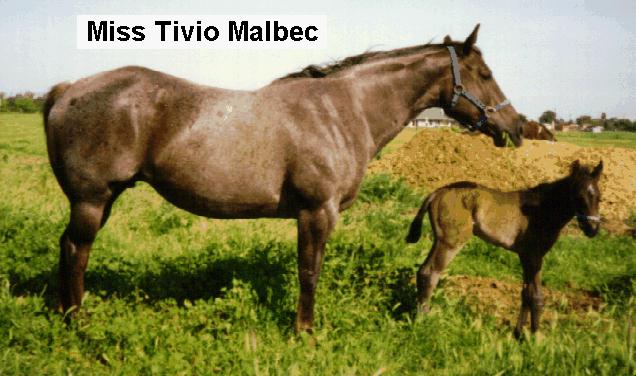Batty Atty Acres
(http://www.geocities.com/sbatteate)(209) 477-1536, J. Sharon Batteate ( [email protected]), PO Box 8535, Stockton, CA 95208
He has been leased until Dec 2010 to Denise Charpilloz. If you are interested in breeding to him, please contact Denise at 360-695-4536 or email Denise Charpilloz or visit her website Sharp Pillows and Owl Glenn Ranch.
Ima Star Brindle Bar
1997 AQHA stallion (#3625847)
Bay Seasonal Brindle carrier
Pedigree
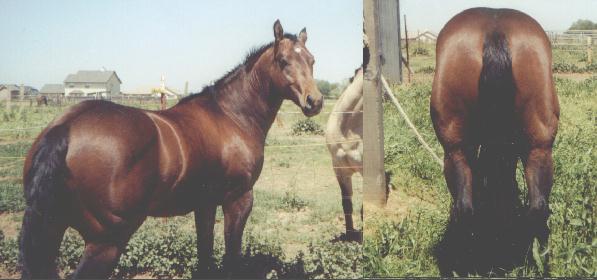
1997 mahogany bay AQHA stallion (3625847) out of Im A Star Moon Bar (Star) by the seal brown roan AQHA stallion Malbec's Silvery Moon. He is a solid mahogany bay color with no white hairs on his body at all, only a small star on his forehead, indicating he did not inherit the roan gene from his sire. However, I thought he might be a carrier of Star's type of brindle pattern (seasonal brindle) because of his unusual curly texturing on his legs, and his sparser mane and tail (like his dam Star). However, he doesn't actually exhibit any striping himself (not even seasonally). I had to wait until he was old enough to do test breedings to confirm if he was a carrier of the seasonal brindle pattern or not. He sired five foals from the test breedings, reproducing the seasonal brindle pattern on non-brindle mares, indicating that he is indeed a carrier of the seasonal brindle pattern.
Offspring - from Brindle Mares
Brindles expected, 50% to 75% - to date from limited foals, 100%
Click each photo for a larger photo and more information - Use back button to return to this table.
Picture
of Dam |
Dam's Name
Breed |
Dam's Base
Color / Pattern |
Picture
of Foal |
Foal's Name,
Breed, & Reg. |
Foal's Base
Color / Pattern |
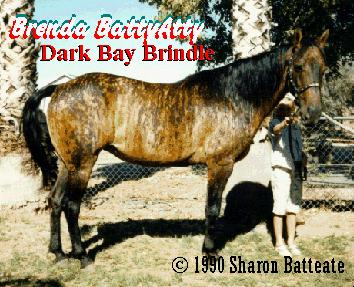 | Brenda Batty Atty
IBHA T-14356
ABRA T-9049 | Dark Bay
Brindle
Foundation mare |  | Brenda's Millennium
1/2 Quarter Registry
# 12502 1/2 | Bay and White
Brindle
2000 Filly |
 | Brenda Batty Atty
IBHA T-14356
ABRA T-9049 | Dark Bay
Brindle
Foundation mare | 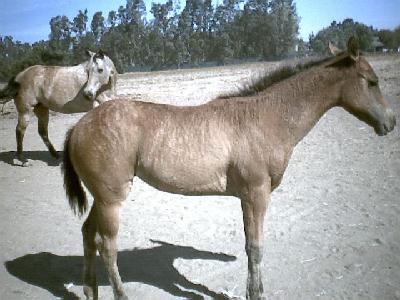 | Brenda's Girly Girl
IBHA - A23667 | Red Bay
Brindle
2003 Filly |
Offspring - from Non-Brindle Mares
Brindles expected, 50% - to date from limited foals, 66%
Click each photo for a larger photo and more information - Use back button to return to this table.
Picture
of Dam |
Dam's Name
Breed |
Dam's Base
Color / Pattern |
Picture
of Foal |
Foal's Name,
Breed, & Reg. |
Foal's Base
Color / Pattern |
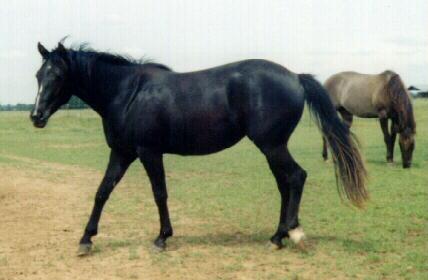 | Brenda's Shadow
1/2 Quarter Registry
# 12156 1/2 | Black
non-brindle
daughter of Brenda |  | Shadow's One
1/2 Quarter Registry
# 12501 1/2 | Mahogany Bay
Seasonal Brindle
2001 Filly |
 | Brenda's Shadow
1/2 Quarter Registry
# 12156 1/2 | Black
non-brindle
daughter of Brenda | 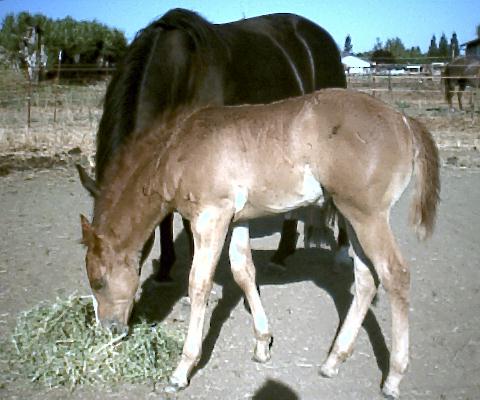 | Shadow's Red Man
1/2 Quarter Registry
# 12618 1/2 | Sorrel
indeterminate
2003 Colt |
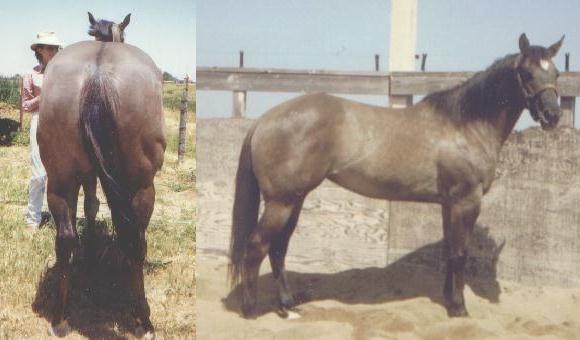 | Going Batty Atty
AQHA 2865499
ABRA TG-8618 | Grullo
non-brindle
no relation |  | Brindle Batty Atty
AQHA # 4393424 | Dun
Seasonal Brindle
2003 Filly |
Pedigree
Sire (of Ima Star Brindle Bar) : Malbec's Silvery Moon

Dam (of Ima Star Brindle Bar) : Im A Star Moon Bar
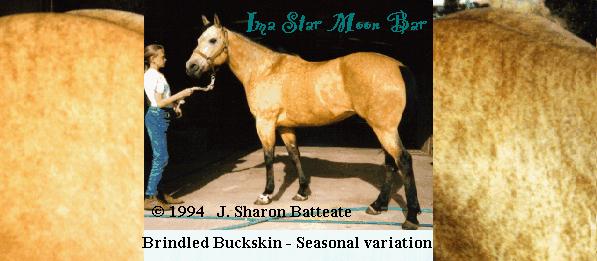
Star is a 1985 AQHA (2386655) mare. Star's base color is buckskin, however, she was registered with the AQHA as a red roan, probably because seasonally there are lighter (almost white) streaks in her coat. Also, she only shows her darker brindling seasonally, unlike Brenda (my other brindled mare) whose brindle pattern is visible year round. While this may be the effect of modifying genes on a single basic gene for brindle, I feel it is more likely that the brindle pattern Star carries may not be the same genetically as the brindle pattern Brenda carries. This would mean that there are possibly several genes producing a phenotypical (outwardly appearing) brindle pattern, similar to paints/pintos, in which there are several genes which produce white spotting.

Star has produced three foals to date, 2 of which carry her seasonal pattern. This indicates there may be a gene involved, which is inherited dominately, since approximately 50% of her foals have inherited the pattern from her. In addition, one of her colts has also produced brindled foals, indicating the pattern is capable of being passed from generation to generation, also lending support to the idea of gene for brindle.
General Information
The Brindle pattern consists of a watery or drippy looking striping (sometimes just partial striping) over the body of an animal. It is more commonly seen in dogs or cattle. In horses, the pattern is extremely rare. Brindle has occurred in such diverse breeds as Arabians, Thoroughbreds, Mustangs, Quarter Horses, Tennessee Walking Horses, German and Bavarian Warmbloods, Russian Horses, Spanish Horses, and also in Donkeys and Mules.
Many people confuse the Brindle pattern with Dun Factor markings (stripe down the back, barring on the legs, and occasional regular-spaced striping down the ribs). At one time, it was thought Brindle was a just a variation of Dun Factor. Indeed, there have been many examples of horses that were probably carrying both Dun Factor and Brindle. However, as can be seen from pictures of numerous Brindles in our slideshow, many do not have any Dun Factor markings whatsoever, indicating the two patterns are probably distinct genetically.
Brindle horses also have texturing in their coat, similar to that seen in some Appaloosa horses. The pattern seems to be inheritable, especially in terms of coat texturing, but the expression of the darker or more intense pigment to make the pattern visible is highly variable, and even varies with individual horses seasonally / yearly. Sometimes the pattern seems to be composed of dark hair (black or brown), sometimes of white hair (roan or gray).
Information collected since 1990 on Brindle horses is now shedding some light on the Brindle pattern. It now appears there may be two ways in which a Brindle phenotype (outward appearance) can occur. In some horses, the pattern has not been inheritable, pointing to a possible mosaic or chimera origin, such as seen in tortoiseshell cats. In other horses, the pattern has been shown to be inheritable. However, there could be several genes involved, producing similar patterns (much as pinto/paint spotting can result from several different genes).
For more information on Brindle Horses, visit the Brindle Horse website at http://members.aol.com/brindlehos/
Update & Contact Information
Written information was last updated © January 30, 2005.
Unless otherwise noted, the articles on this site are by J. Sharon Batteate [email protected] The pictures and information on this site are for informational purposes, in order to educate people on the Brindle pattern. The pictures and information on this site are copyrighted. All rights reserved. No part may be reproduced, stored in a retrieval system, or transmitted in any form or by any means, electronic, mechanical, photocopying, recording, or otherwise, without the prior permission of the copyright holders.
You may also contact me: (209) 477-1536, J. Sharon Batteate, PO Box 8535, Stockton, CA 95208 USA











